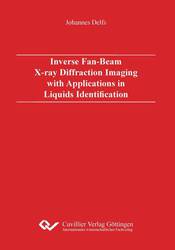| Areas | |
|---|---|
| Serie de libros (96) |
1378
|
| Nachhaltigkeit |
3
|
| Gesundheitswesen |
1
|
| Letra |
2363
|
| Ciencias Naturales |
5406
|
| Matemática | 229 |
| Informática | 319 |
| Física | 980 |
| Química | 1363 |
| Geociencias | 131 |
| Medicina humana | 243 |
| Estomatología | 10 |
| Veterinaria | 108 |
| Farmacia | 147 |
| Biología | 835 |
| Bioquímica, biología molecular, tecnología genética | 121 |
| Biofísica | 25 |
| Nutrición | 45 |
| Agricultura | 1004 |
| Silvicultura | 201 |
| Horticultura | 20 |
| Ecología y conservación de la tierra | 148 |
| Ciencias Ingeniería |
1791
|
| General |
98
|
|
Leitlinien Unfallchirurgie
5. Auflage bestellen |
|
Erweiterte Suche
Inverse Fan-Beam X-ray Diffraction Imaging with Applications in Liquids Identification (Tienda española)
Johannes Delfs (Autor)Previo
Lectura de prueba, PDF (140 KB)
Indice, PDF (47 KB)
The Inverse Fan-beam (IF) confi guration for X-ray Diffraction Imaging (XDI) and its capability of identifying liquid and amorphous substances for the purpose of explosive detection are described and investigated. Material specifi c information can be obtained by measuring x-ray diffraction profi-les from selected volume elements within inhomogeneous extended objects. This new technique can be used to fi ngerprint liquid explosives and may eliminate the inconvenience, uncertainty, and expense associated with monitoring liquids separately from hand luggage at airport checkpoints. Design concepts for multi-detector arrangements, a multidirectional primary collimator and the scatter imaging collimator are presented and evaluated using numerical procedures.
A computer program using ray-tracing methods is described for calculating the primary beam profi le, the scattering angle distribution, and the radiation effi ciency with respect to the x-ray collimation geometry. Synchrotron x-ray diffraction measurements were performed on various liquids which are of interest for security applications. The diffraction profi les are presented and the key features which are potentially suitable for the purpose of explosive detection identifi ed. Material specific information is obtained about the morphology and its effective atomic number.
Several additional parameters describing the structure and density of the object under investigation can be derived from the peaks in the molecular interference function.
| ISBN-13 (Impresion) | 9783954044429 |
| ISBN-13 (E-Book) | 9783736944428 |
| Formato | A5 |
| Idioma | Inglés |
| Numero de paginas | 126 |
| Laminacion de la cubierta | Brillante |
| Edicion | 1. Aufl. |
| Lugar de publicacion | Göttingen |
| Lugar de la disertacion | Hamburg |
| Fecha de publicacion | 28.06.2013 |
| Clasificacion simple | Tesis doctoral |
| Area |
Física
|
| Palabras claves | X-ray Diffraction Imaging, Inverse Fan-Beam, Multi-directional Primary Collimator, Liquids Identification, Liquid Explosives Detection, Airport Baggage Inspection, Physik der kondensierten Materie |
| URL para pagina web externa | http://www.physnet.uni-hamburg.de |








